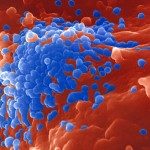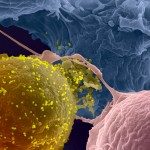Link to Pubmed [PMID] – 16378963
J. Virol. 2006 Jan;80(2):605-14
Foamy viruses (FVs) are nonpathogenic retroviruses infecting many species of mammals, notably primates, cattle, and cats. We have examined whether members of the apolipoprotein B-editing catalytic polypeptide-like subunit (APOBEC) family of antiviral cytidine deaminases restrict replication of simian FV. We show that human APOBEC3G is a potent inhibitor of FV infectivity in cell culture experiments. This antiviral activity is associated with cytidine editing of the viral genome. Both molecular FV clones and primary uncloned viruses were susceptible to APOBEC3G, and viral infectivity was also inhibited by murine and simian APOBEC3G homologues, as well as by human APOBEC3F. Wild-type and bet-deleted viruses were similarly sensitive to this antiviral activity, suggesting that Bet does not significantly counteract APOBEC proteins. Moreover, we did not detect FV sequences that may have been targeted by APOBEC in naturally infected macaques, but we observed a few G-to-A substitutions in humans that have been accidentally contaminated by simian FV. In infected hosts, the persistence strategy employed by FV might be based on low levels of replication, as well as avoidance of cells expressing large amounts of active cytidine deaminases.






